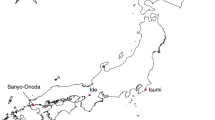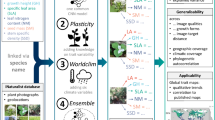Abstract
Geographical information about collection points of plant genetic resources and photographs of plants and their habitats have been accumulated into a genetic resources database. Recently, climate data such as temperature and precipitation data have become available on the Internet. The characteristic shape and color of some plants and seeds are closely related to their habitat environment. Evaluation of the relationship between a plant’s image and its habitat environment as a feature quantity should make it possible to estimate the habitat of a plant from its morphological characteristics. The ability to estimate the habitat should increase exploration and plant collection efficiency. Deep learning was applied to the analysis of plant images. Then, a deep convolutional activation feature derived from the seed images by deep learning was used to develop an estimation system for classifying pairs of plant species. An estimation system for classifying the habitat climate from seed images was also developed.



Similar content being viewed by others
References
Plucknett DL, Smith NJH, Williams JT, Anishetty NM (1987) Gene banks and the world’s food. Princeton University Press, Princeton
Takeya M, Yamasaki F, Uzuhashi S, Aoki T, Sawada H, Nagai T, Tomioka K, Tomooka N, Sato T, Kawase M (2011) NIASGBdb: NIAS Genebank databases for genetic resources and plant disease information. Nucleic Acids Res 39(suppl 1):D1108–D1113
Matsubayashi KW, Fujiyama N (2016) Ecological speciation (in Japanese). Jpn J Ecol 66:561–580
WorldClim. http://worldclim.org/version2. Accessed 13 March 2018
Krizhevsky A, Sutskever I, Hinton GE (2012) Imagenet classification with deep convolutional neural networks. Adv Neural Inf Process Syst 25:1097–1105
Sun Y, Liu Y, Wang G, Zhang H (2017) Deep learning for plant identification in natural environment. Comput Intell Neurosci 2017:7361042
Donahue J, Jia Y, Vinyals O, Hoffman J, Zhang N, Tzeng E, Darrell T (2013) Decaf: a deep convolutional activation feature for generic visual recognition. arXiv:1310.1531
Xu Y, Jia Z, Wang LB, Ai Y, Zhang F, Lai M, Chang EIC (2017) Large scale tissue histopathology image classification, segmentation, and visualization via deep convolutional activation features. BMC Bioinform 18:281. https://doi.org/10.1186/s12859-017-1685-x
NARO Genebank. https://www.gene.affrc.go.jp/. Accessed 12 March 2018
Deng J, Dong W, Socher R, Li LJ, Li K, Li FF (2009) Imagenet: a large-scale hierarchical image database. In: IEEE conference on computer vision and pattern recognition, 2009. CVPR 2009. IEEE
Image Category Classification Using Deep Learning. https://jp.mathworks.com/help/vision/examples/image-category-classification-using-deep-learning.html?lang=en. Accessed 12 March 2018
Fick SE, Hijmans RJ (2017) WorldClim 2: new 1-km spatial resolution climate surfaces for global land areas. Int J Climatol 37(12):4302–4315. https://doi.org/10.1002/joc.5086
Author information
Authors and Affiliations
Corresponding author
About this article
Cite this article
Takeya, M., Yamasaki, F. Development of an estimation system based on the relationship between plant genetic resource images and environmental information for the collection point. Artif Life Robotics 24, 24–27 (2019). https://doi.org/10.1007/s10015-018-0434-1
Received:
Accepted:
Published:
Issue Date:
DOI: https://doi.org/10.1007/s10015-018-0434-1




